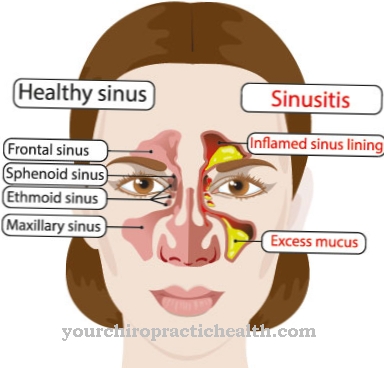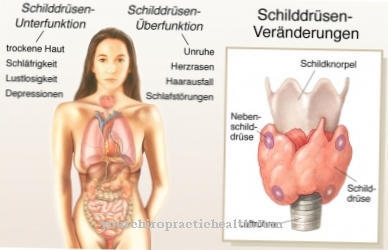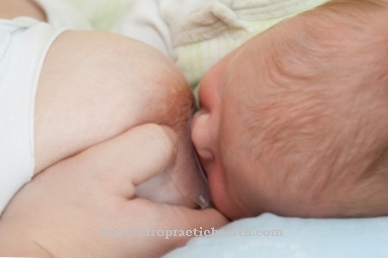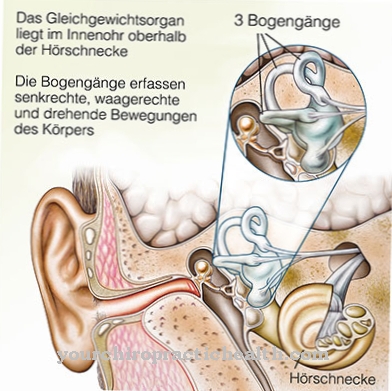In psychology means a Impulse control disorder compulsive and uncontrollable behavior that those affected display under tension. The respective, impulsively performed action leads to a brief release of tension.
What are the characteristics of an impulse control disorder?

© tonaquatic - stock.adobe.com
Characteristic for Impulse control disorders is that the affected people are unable to withstand their impulse. The decision to carry out a certain action is not made and carried out consciously. In addition, the various impulses do not pursue any goal. A typical impulse control disorder is, for example, pathological stealing, which is also known as kleptomania.
People who obsessively steal do not pursue motives such as enrichment, envy or harm to another person. They steal involuntarily and have no interest in the stolen items and often hide or even destroy them. Other impulse control disorders are shopping addiction, food addiction, gambling addiction, the addiction to masturbate and the compulsion to injure one's own body by scratching or pulling out hair and nails.
Basically, an impulsive action can be divided into five different action sections. After the first impulse, the desire to do it grows, which is associated with high tension. This is reduced by performing the compulsive act and leads to brief relaxation. The last phase, which doesn't always happen, is characterized by feelings of guilt.
causes
The causes of impulse control disorders have not yet been conclusively researched. In all likelihood, however, the disorders are triggered by a complex interplay of genetic and physical foundations, upbringing, environment and experience. In addition, researchers suspect that the hormone level of those affected is relevant to the problem and has a decisive influence on the type of disorder.
Men have higher testosterone levels than women and are more prone to aggressive disorders, such as compulsive arson. Women, on the other hand, engage in less aggressive compulsive acts, which, however, are often self-destructive. Trichotillomania, the compulsion to pull hair out, is a compulsive act that is often carried out by women. In addition, the question of the extent to which impulse control disorders are linked to other mental disorders is investigated. The link with substance addictions and serious mental illnesses such as borderline personality disorder, for example, is particularly important.
Symptoms, ailments & signs
The symptoms of impulse control disorder are not always specific as there are many different forms of the disease. In addition, those affected are usually not aware of their own behavior. In children, behavior patterns that are typical of children, such as spontaneity or seemingly pointless actions, can easily be confused with mental disorders.
In the USA in particular, there is a tendency towards the rapid administration of psychotropic drugs if there is a suspicion of a mental illness in childhood. A possible mental disorder should always be considered in connection with the age and environment of the person concerned. Possible behaviors that offer the first clues are, for example, lying, stealing, aggressive and autoaggressive behavior and the tendency to high-risk or obsessive sexual behavior.
Wounds, bald spots and chewed fingernails can also be signs of possible compulsive actions. Those affected also often suffer from obsessive-compulsive thoughts, pursue ideas that appear irrational, and have difficulty concentrating. Since impulse control disorders always occur when the person concerned is overwhelmed by the situation they are in, the psychological condition is an important factor.
People who suffer from lack of impulse control are often depressed, suspicious, feeling left alone and suffering from low self-esteem.
Diagnosis & course of disease
The diagnosis of whether there is an impulse control disorder must always be made by a specialist. This is not always easy to diagnose, as some disorders, such as compulsive eating or shopping, are on the one hand socially acceptable to a certain extent and on the other hand also overlap with addictions. Compulsive fire-setting is not necessarily comparable to gambling addiction, and eating disorders can also be understood as a conscious attempt to gain control of the body or as an unconscious compensatory act.
Complications
Complications in this clinical picture are very different, since the impulse control disorder can be a symptom of several diseases. The need to buy, for example, often means a great financial burden. Some people also spend more than they can afford, or they spend money that was intended for other purposes. This can lead to considerable interpersonal tension with those around you.
Something similar also applies to gambling addiction. Gambling addicts also often neglect their families and friends. Professional complications can also arise - for example, if you are absent, perform poorly or play games (for example on a computer or mobile phone) during working hours.
People with trichotillomania pluck their own hair. This can cause bald spots to develop that are not very aesthetic. When the eyebrows are completely removed, sweat from the forehead can trickle into the eyes. The eyelashes also protect the eyes; if the trichotillomaniac pulls them out, their protective effect is also missing. In addition, the human body is unable to digest hair. This can create a ball of hair in the intestine. Such a so-called bezoar can lead to intestinal obstruction.
Kleptomaniacs may have to face the legal consequences of their pathological stealing. This also applies to pyromaniacs if they set fire to someone else's property or violate regulations. In some cases, pyromaniacs suffer injuries when setting an object on fire. All impulse control disorders can be associated with other mental illnesses, such as depression.
When should you go to the doctor?
People with abnormal behavior or sudden changes in behavior should always be examined and treated by a doctor. If there are spontaneous, uncontrolled outbursts of anger, violence or verbal attacks, a doctor or therapist is needed. If a person's mood repeatedly changes from a harmless to an aggressive or angry demeanor within seconds or minutes, a doctor should be consulted.
The clinical picture of an impulse control disorder includes the lack of insight into a discrepancy. For this reason, special sensitivity in dealing with the person affected is necessary. A special relationship of trust is important so that people with increased impulsiveness or with problems controlling emotions see a doctor.
If the behavior of the person concerned is experienced as above the norm, a doctor should be asked for advice.People who are colloquially perceived as choleric, raving or furious can learn to change their behavior through therapeutic support. Uncontrolled behavior is perceived as frightening by people in the area and should be discussed with the person concerned and a doctor.
Relatives are well advised to seek information from a specialist in order to be able to show correct behavior in dealing with the person concerned. If the impulse control disorder increases in intensity or if it poses a threat to others, a medical officer can be appointed.
Therapy & Treatment
Basically, those affected can be treated with drugs under the supervision of a psychiatrist or they can choose a non-drug therapy approach such as talk therapy, behavior therapy or psychoanalysis. It is important to clearly define the therapy goals. On the one hand, there is the possibility of completely suppressing undesired behavior and, on the other hand, the goal of modifying the compulsive action and reducing it to a harmless level.
A preliminary consideration in order to determine the therapy goal is, for example, the extent to which the person concerned is physically harming themselves. In addition, the social and legal context of the action must be considered. For example, compulsive stealing is valued differently than compulsive buying. The therapist must also assess whether the patient is able to reduce the harmful behavior to a harmless level. And of course it should not be forgotten whether the person concerned is willing to cooperate. In the case of children in particular, patients are often unaware of the seriousness of the situation.
You can find your medication here
➔ Medicines to calm down and strengthen nervesOutlook & forecast
The prognosis depends on the cause or underlying illness of the person concerned. In many cases, behavior therapy or other psychological support can improve the symptoms. With an insight into the disease and the cooperation of the patient, the affected person receives a good prognosis. With an optimal treatment plan, changes are achieved gradually until symptoms are free.
With a low intensity of the impulse control disorder, a significant relief of the symptoms can be achieved after a few months. There is a behavioral regulation that is based on intensive training. The more pronounced the disorder, the longer the treatment normally takes. The difficulty is in keeping the patient motivated until the end of the treatment. Initiated therapies can be discontinued, which makes a good prognosis more difficult.
If the impulse control disorder is based on a mental disorder, the prognosis worsens. In the case of reduced intelligence or severe mental illness, the person concerned is dependent on daily care. Medical care is needed in severe cases. In many cases, a cure is not achieved in these patients. Long-term therapy is required so that gradual optimizations can be implemented. As soon as prescribed drugs are discontinued, a relapse is to be expected.
prevention
Mental illnesses such as impulse control disorders are unavoidable and affect people of all ages, genders, and social backgrounds. As with all mental illnesses, a stable environment that promotes personal development minimizes and strengthens the chance of getting sick. Social contacts, abstaining from drugs and other addictive substances and a fulfilling everyday life provide a good basis for a life without illness.
Aftercare
A successfully treated impulse control disorder requires lifelong follow-up care. Otherwise, the risk of recurrence of this mental disorder is increased. In psychological therapy, those affected have usually learned strategies for dealing with stressful situations without displaying impulsive behavior.
In the context of aftercare, it is relevant to internalize these learned mechanisms further and to always apply them. As soon as patients notice that they are again prone to impulsive actions, they immediately contact their former psychiatrist. Because aftercare also includes taking measures to prevent new phases of the disease.
Life situations associated with stress also increase the risk that those affected will develop an impulse control disorder again. Then it is necessary that one's own actions are critically questioned and that a psychological counseling center or the former psychologist be visited as soon as possible. All activities that promote mental stability, from yoga to sports to meditation, are also helpful.
Self-help groups also provide important support for many people who have received professional treatment. Here, patients receive support from like-minded people and may be made aware of relapsing behavior before they admit it to themselves. In either case, follow-up care for impulse control disorder is a lifelong process.
You can do that yourself
The actions people with impulse control disorder can take vary widely and depend on the type of disorder. It should be noted that a holistic therapy of the disorder distinguishes, for example, between self-damaging (compulsive hair-plucking) and criminal or externally damaging (compulsive fire-setting) behavior.
It should be noted that, in the vast majority of cases, impulse control damage cannot be managed alone. The decisive factor is a willingness to treat the affected person and consequently following the steps. Only afterwards and during the process can one speak of self-help measures. These essentially consist in finding substitute actions that release the tension that has built up. It should be possible to carry out this substitute action anywhere without any problems in order to protect against relapses as much as possible. In impulse control disorders that involve the hands, for example, those affected can sit on them to prevent impulse-controlled action. Such measures may have to be worked out with a therapist.
In the case of an impulse control disorder, the goal is usually not to eliminate the disorder, as this is currently hardly possible. Instead, valves must be created that the person affected can use and which, ideally, also have another benefit. In connection with the fact that it is a matter of releasing the urge to pursue the disorder, it is incumbent on those affected within the framework of exploratory therapy to find suitable options in their everyday life that are incorporated into the further course of therapy.


.jpg)










.jpg)

.jpg)












